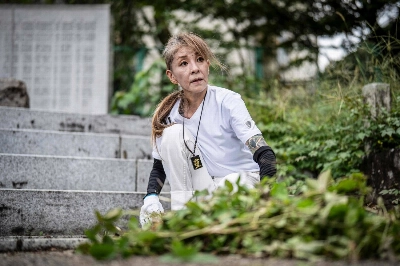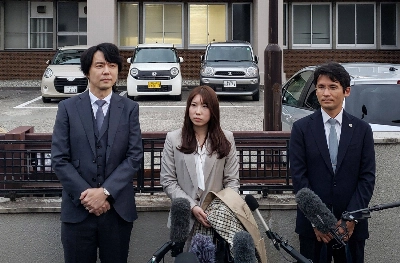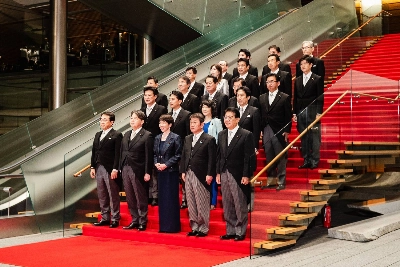Thinking "green" may seem to be a modern notion, but in Japan it's as old as the hills -- at least those ones climbed by innumerable yamabushi ascetics on grueling mountain pilgrimages in search of enlightenment.
 |
| Mt. Fuji seen at sunset from Zushi in Kanagawa Prefecture. (Eric Prideaux Photo) |
Through all the centuries they have been hiking up divine slopes, yamabushi -- the guys shown in tourist guides wearing baggy white knickerbockers and flowing sleeves -- have minimized their impact on the environment by carrying only the bare essentials and living off the land. (When answering their calls of nature, too, they are said to have once adopted a similarly thoughtful approach -- by spreading paper on the ground to shield the local mountain god from impurity, and, it is thought, burying the whole shebang in the ground.)
But today, with yamabushi infinitely outnumbered by tourists and trekkers discharging all manner of refuse willy-nilly as they go, the average mountain deity must be feeling, well, dumped on.
Nowhere is this situation quite as dire as on the symmetrical slopes of Mount Fuji, the venerated home of the Shinto goddess Konohana Sakuya Hime. Long considered the greatest symbol of Japan's natural beauty, the world-famous conical peak 100 km west of Tokyo has, in modern times, come to more closely resemble a symbol of Japan's low level of collective environmental concern.
"Mountains of garbage pile up," lamented Naoko Aoki of the Fuji-san Club, a group formed in 1998 to clean up the 3,776-meter mountain after a bid to have it listed as a UNESCO World Heritage Site was abandoned partly due to the mess caking its flanks.
Mob-related firms
In addition to Mount Fuji's annual quota of some 3 million tourists and trekkers, however, other prime eco-offenders include mob-related firms that dump construction materials under cover of darkness to avoid paying for legitimate disposal. In recent years, literally thousands of canisters of spent chemicals have been found buried on the mountain's lower slopes, left to leak their toxic contents into the soil and groundwater.
There are countless bags of household garbage strewn about by local residents, old PCs discarded by people to evade recycling taxes and all those little thingamajigs -- from used lighters to fishing weights and knotted line -- that are discarded in mountain lakes and then choke birds and fish.
All in all, Japan's grandest treasure has become a national embarrassment.
Six years after it started, though, the Fuji-san Club is scoring some notable successes in bringing citizens and corporations together to address the problem. This year alone, for instance, nearly 2,000 people -- from young students to retirees -- have already made the group's garbage-collection drive its biggest in the three years they has been running.
Computer database
In a related effort, volunteers transmit photos of trash heaps from their GPS-equipped cellular phones to a computer database which the Fuji-san Club uses to create a detailed "garbage map" it publishes on the Web. Of course, the map also helps it direct cleanup crews to the more than 217 dump sites it has pinpointed around the mountain.
 |
| A clean-up volunteer beams images of an illegal dump site to a computer database. (Photo courtesy of Fuji-san Club) |
But back to those yamabushi and their calls of nature. A major blight on Mount Fuji are the toilets at the summit and at "stations" on the way. Until last year, these were simply emptied on to the slopes after every July-August climbing season, besmirching them with raw sewage and toilet paper and creating one hell of a stench.
Then, a few years ago, at the summit the Fuji-san Club installed ecofriendly toilets loaded with microorganisms that break down organic waste, and -- lo and behold -- they were hailed a success. But no nonprofit organization like this can instantly tackle an entire mountain by itself, and the initiative may have taken years to replace all the facilities had government agencies not put in all-important cash. By the time the 2006 climbing season comes around, all the old-fashioned, polluting toilets on Mount Fuji are expected to be nothing but a shameful and distasteful memory.
Meanwhile, prefectural authorities are also cracking down on industrial dumpers. Through the simple expedient of instituting late-night spot checks at which truck drivers have to account for themselves and show paperwork for their loads, illegal dumping in some areas has been halved. Telephone hotlines, meanwhile, allow the public to get involved by reporting suspicious nocturnal visitors.
"We want dumpers to know the people are watching," said Toshikazu Inaba, an official with Shizuoka Prefecture, which shares Mount Fuji with Yamanashi Prefecture on its northeastern flank.
Huge obstacles
A Yamanashi prefectural official said that volunteers and public agencies picked up 147 tons of garbage last year, the first period for which the prefecture has such data. In Shizuoka, 41 tons of industrial waste were collected during the same period, down from 93 tons the year before. (Other data on waste were not available, and the national government has never come out with any comprehensive figures for Mount Fuji cleanups.)
So, although there are encouraging signs that the authorities -- spurred or shamed by nonprofit organizations -- are finally cleaning up their acts, there remain huge obstacles to be overcome.
Unsurprisingly, a key one is cost. The late-night prefectural monitors carry handheld computers loaded with truck-registration data, and that requires a sizable investment. And officials are unsure whether the voluntary 200 yen fee requested of those who use the biotoilets will cover the costs of upkeep.
Perhaps the toughest hurdle, though, is public apathy.
"There's no end to the work. We clean up and they just litter again," said Aoki. "During the months when families tend to relocate, you find furniture -- the entire contents of a house -- just chucked out there."
All the same, even without any immediate victory in sight (any World Heritage Site listing still appears far off) the efforts are worth it. This is, as any yamabushi would agree, about more than just protecting the environment. It is about social self-respect and tradition.
"If Japan really treasures Mount Fuji, it will want to pass it on in pristine shape," said Aoki. "At this rate, though, our descendants 100 years hence will say we bequeathed them a mountain of shame."

















With your current subscription plan you can comment on stories. However, before writing your first comment, please create a display name in the Profile section of your subscriber account page.